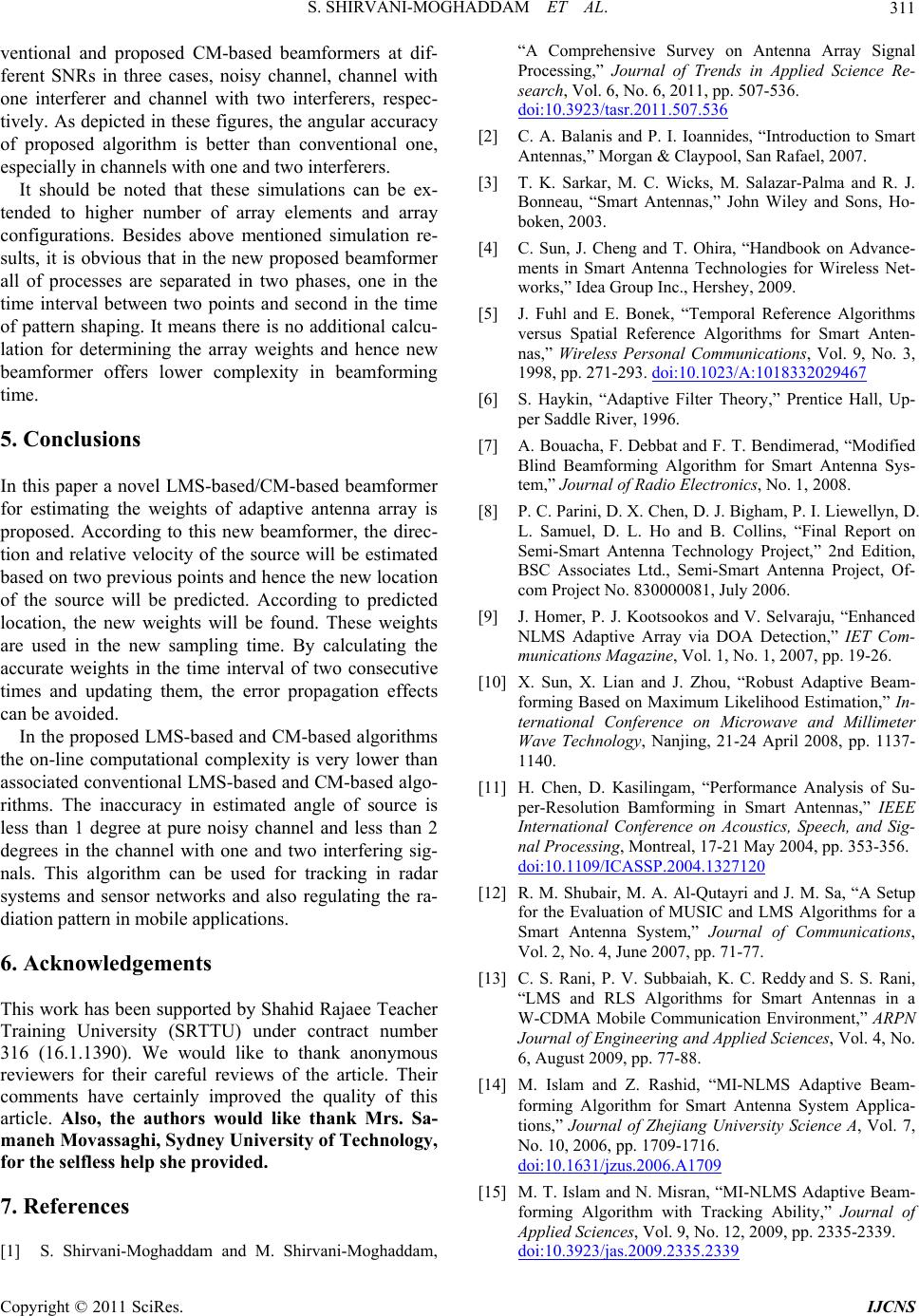
S. SHIRVANI-MOGHADDAM ET AL.
Copyright © 2011 SciRes. IJCNS
311
ventional and proposed CM-based beamformers at dif-
ferent SNRs in three cases, noisy channel, channel with
one interferer and channel with two interferers, respec-
tively. As depicted in these figures, the angular accuracy
of proposed algorithm is better than conventional one,
especially in channels with one and two interferers.
It should be noted that these simulations can be ex-
tended to higher number of array elements and array
configurations. Besides above mentioned simulation re-
sults, it is obvious that in the new proposed beamformer
all of processes are separated in two phases, one in the
time interval between two points and second in the time
of pattern shaping. It means there is no additional calcu-
lation for determining the array weights and hence new
beamformer offers lower complexity in beamforming
time.
5. Conclusions
In this paper a novel LMS-based/CM-based beamformer
for estimating the weights of adaptive antenna array is
proposed. According to this new beamformer, the direc-
tion and relative velocity of the source will be estimated
based on two previous points and hence the new location
of the source will be predicted. According to predicted
location, the new weights will be found. These weights
are used in the new sampling time. By calculating the
accurate weights in the time interval of two consecutive
times and updating them, the error propagation effects
can be avoided.
In the proposed LMS-based and CM-based algorithms
the on-line computational complexity is very lower than
associated conventional LMS-based and CM-based algo-
rithms. The inaccuracy in estimated angle of source is
less than 1 degree at pure noisy channel and less than 2
degrees in the channel with one and two interfering sig-
nals. This algorithm can be used for tracking in radar
systems and sensor networks and also regulating the ra-
diation pattern in mobile applications.
6. Acknowledgements
This work has been supported by Shahid Rajaee Teacher
Training University (SRTTU) under contract number
316 (16.1.1390). We would like to thank anonymous
reviewers for their careful reviews of the article. Their
comments have certainly improved the quality of this
article. Also, the authors would like thank Mrs. Sa-
maneh Mova ssaghi, Sydney University of Technology,
for the selfless help she provided.
7. References
[1] S. Shirvani-Moghaddam and M. Shirvani-Moghaddam,
“A Comprehensive Survey on Antenna Array Signal
Processing,” Journal of Trends in Applied Science Re-
search, Vol. 6, No. 6, 2011, pp. 507-536.
doi:10.3923/tasr.2011.507.536
[2] C. A. Balanis and P. I. Ioannides, “Introduction to Smart
Antennas,” Morgan & Claypool, San Rafael, 2007.
[3] T. K. Sarkar, M. C. Wicks, M. Salazar-Palma and R. J.
Bonneau, “Smart Antennas,” John Wiley and Sons, Ho-
boken, 2003.
[4] C. Sun, J. Cheng and T. Ohira, “Handbook on Advance-
ments in Smart Antenna Technologies for Wireless Net-
works,” Idea Group Inc., Hershey, 2009.
[5] J. Fuhl and E. Bonek, “Temporal Reference Algorithms
versus Spatial Reference Algorithms for Smart Anten-
nas,” Wireless Personal Communications, Vol. 9, No. 3,
1998, pp. 271-293. doi:10.1023/A:1018332029467
[6] S. Haykin, “Adaptive Filter Theory,” Prentice Hall, Up-
per Saddle River, 1996.
[7] A. Bouacha, F. Debbat and F. T. Bendimerad, “Modified
Blind Beamforming Algorithm for Smart Antenna Sys-
tem,” Journal of Radio Electronics, No. 1, 2008.
[8] P. C. Parini, D. X. Chen, D. J. Bigham, P. I. Liewellyn, D.
L. Samuel, D. L. Ho and B. Collins, “Final Report on
Semi-Smart Antenna Technology Project,” 2nd Edition,
BSC Associates Ltd., Semi-Smart Antenna Project, Of-
com Project No. 830000081, July 2006.
[9] J. Homer, P. J. Kootsookos and V. Selvaraju, “Enhanced
NLMS Adaptive Array via DOA Detection,” IET Com-
munications Magazine, Vol. 1, No. 1, 2007, pp. 19-26.
[10] X. Sun, X. Lian and J. Zhou, “Robust Adaptive Beam-
forming Based on Maximum Likelihood Estimation,” In-
ternational Conference on Microwave and Millimeter
Wave Technology, Nanjing, 21-24 April 2008, pp. 1137-
1140.
[11] H. Chen, D. Kasilingam, “Performance Analysis of Su-
per-Resolution Bamforming in Smart Antennas,” IEEE
International Conference on Acoustics, Speech, and Sig-
nal Processing, Montreal, 17-21 May 2004, pp. 353-356.
doi:10.1109/ICASSP.2004.1327120
[12] R. M. Shubair, M. A. Al-Qutayri and J. M. Sa, “A Setup
for the Evaluation of MUSIC and LMS Algorithms for a
Smart Antenna System,” Journal of Communications,
Vol. 2, No. 4, June 2007, pp. 71-77.
[13] C. S. Rani, P. V. Subbaiah, K. C. Reddy and S. S. Rani,
“LMS and RLS Algorithms for Smart Antennas in a
W-CDMA Mobile Communication Environment,” ARPN
Journal of Engineering and Applied Sciences, Vol. 4, No.
6, August 2009, pp. 77-88.
[14] M. Islam and Z. Rashid, “MI-NLMS Adaptive Beam-
forming Algorithm for Smart Antenna System Applica-
tions,” Journal of Zhejiang University Science A, Vol. 7,
No. 10, 2006, pp. 1709-1716.
doi:10.1631/jzus.2006.A1709
[15] M. T. Islam and N. Misran, “MI-NLMS Adaptive Beam-
forming Algorithm with Tracking Ability,” Journal of
Applied Sciences, Vol. 9, No. 12, 2009, pp. 2335-2339.
doi:10.3923/jas.2009.2335.2339